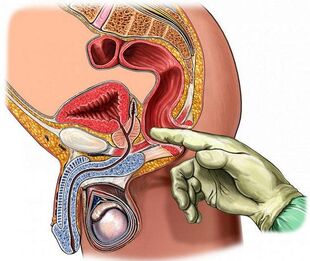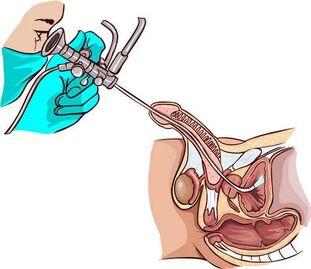
The more complete and competent the diagnosis of prostatitis, the more effective the subsequent therapy. A formal approach by a doctor can result in a long and ineffective treatment for the patient. The condition is to determine the inflammation of the prostate and all the factors that provoke it.
How doctors diagnose prostatitis
Prostatitis is diagnosed by a urologist or andrologist. After talking to the patient, the doctor prescribes the necessary examinations: first a standard set (blood, urine, prostate secretion, rectal examination), then, if indicated, more detailed and high-tech methods are used: CT, MRI, ultrasound.
Anamnesis apple
During the initial consultation, the doctor will ask the following questions:
- communication period (if shortened, under what conditions);
- Abdominal discomfort during prolonged stay in a static position, as well as after drinking alcohol or hypothermia;
- Frequency and speed of urination (is there any difficulty, an intermittent jet, you often have to get up to use the toilet at night);
- Orgasm quality (still bright or blurred, painful ejaculation).
The more information the patient remembers, the better the clinical picture developed by the doctor.
Differential Diagnostics
The symptoms of prostatitis are similar to the symptoms of a number of other diseases:
- Cystitis (pain when urinating, pain in the abdomen).
- Adenoma (difficulty urinating, heaviness in the groin).
- Prostate cancer (problems with blood in the urine, urinary excretion).
- Rectal pathologies: hemorrhoids, paraproctitis (inflammation), anal fissures, crepitus (ulcerative colitis).
Additional diagnostic methods and basics of use are shown in Table 1.
Table 1. Differential diagnosis of prostatitis
| Disease | Risk Group | Analyzes |
|---|---|---|
| Hyperplasia | Men over 45 years of age with no history of urethritis, catheterization, bladder and urethral trauma (pain, blood in the urine). | Prostate ultrasound and digital examination |
| Prostatitis | Young men with no history of irritants (similar to hyperplasia), recent fever, hypothermia | ultrasound, complete blood count (CBC), digital prostate examination |
| Prostate cancer | Men over 45, no history of provocative factors | Prostate ultrasound, PSA analysis, digital examination |
If necessary, other specialized doctors are involved in the diagnosis: proctologist, neurologist, vertebrologist. The last two experts identify the causes of pain associated with disorders of the spinal structure, nerve endings.
rectal palpation

Digital rectal examination is the most accessible and informative way to check the condition of the prostate. During the procedure, the doctor pays attention to the following parameters of the structure:
- Volume;
- density;
- Surface roughness;
- Homogeneity (tissue homogeneity);
- Borders (contour clarity);
- Protection of the isthmus (longitudinal suture between the lobes).
In prostatitis, the gland grows due to edema (asymmetry is possible), the consistency is elastic, there is no longitudinal groove (suture), and the patient may feel pain when touched.
For this type of diagnosis you needfor a clear pictureprepare:
- Avoid ejaculation, alcohol, heavy physical exertion, hypothermia and overheating the day before.
- Do not ride a bicycle 24 hours a day, do not use rowing machines (do not damage or massage the prostate in this way).
- Before seeing a doctor, make an enema (a micro enema can be used) to clean the ampoule of the rectum.
You can feel the prostate 3-5 cm deep from the anus. The doctor performs the procedure with sterile gloves and lubricates the finger with gel. The patient lies on his side with his knees compressed or standing in an elbow position.
Laboratory Methods
Laboratory methods for the diagnosis of prostatitis include the study of biomaterials for the presence of pathogens.
Blood
Based on the results of general and biochemical blood tests (remove the capillary from the finger), prostatitis may be suspected at an early stage. The analysis is performed in the morning on an empty stomach. You should refrain from smoking for an hour before the procedure.
Important indicators:
- Leukocytes (blood cells that increase in number with a decrease in immunity against the background of inflammatory reactions). Normally 4-9 × 10 ^ 9 units;
- ESR (erythrocyte sedimentation rate). The norm is 5 units, the increase indicates an inflammatory or oncological process;
- Lymphocytes. Normally, the percentage of their total blood cells varies between 18 and 40. It already means infection.
Men over the age of 40 are prescribed a PSA test- a tumor indicator that goes beyond chronic prostatitis or prostate cancer.Norm- less than 4 ng / ml, after 50 years - 5. 53 ng / ml.
Urine
The urethra passes through the prostate (the prostate part of the urethra), so when the gland becomes inflamed, the urine changes color and consistency. Three types of tests are performed to diagnose prostatitis:
- General - determination of physical and chemical parameters. Signs of inflammation of the prostate: urine is cloudy, whitish, alkaline, protein, leukocytes, purulent filaments, sometimes foam or blood. Phosphates are found in significant prostatitis.
- Cytological - examination of the presence of pathologically altered cells. The presence of erythrocytes and epithelium may indicate a tumor process.
- Bacteriological - identifies traces of the activity of pathogenic microorganisms. To do this, prepare a settling jaw in a nutrient medium. If there are bacteria and fungi, after a while they begin to actively multiply. Escherichia coli often causes prostatitis.
You should not eat salty and spicy foods, alcohol and coloring products (beets, coffee) before urinating. The analysis is performed in the morning on an empty stomach.Three glass test methods are used for prostatitis:the patient urinates in each glass in turn; The result is the first, middle and last part. This method allows you to determine the location of inflammation: urethra, prostate, bladder. The four-bottle method is more informative. The last part of the urine is collected after prostate massage to get the secretion.
Prostate secretion and sperm
Juice produced by the prostate gland is a valuable diagnostic material. Prepare the fence in the same way as a rectal digital examination. You should abstain from sexual intercourse for three to five days in order to have enough secretion.
Methods of examination of prostate secretions:
- Microscopy;
- Back planting;
- PCR (polymerase chain reaction).
PCR is the most accurate method. Special enzymes that increase the number of DNA and RNA fragments of pathogens are used to process the biomaterial. You need a special device for research - an amplifier. The most accurate real-time PCR. The result is ready in an hour.
Inflammation of the prostate is associated with the presence in the water of amyloid bodies, staphylococci, streptococci, Pseudomonas aeruginosa, epithelial cells (more than three in the visual field). The number of lipoid granules decreases and the number of leukocytes increases.
Spermogram for prostatitisis an additional analysis. Against the background of inflammation of the prostate, the sperm becomes yellowish or brown, the viscosity increases (becomes liquid for a long time), pathogenic microflora is present. In chronic prostatitis, glandular epithelial cells, amyloid bodies and mucus are found.
Urethral rod

A urethral swab is a less informative method for diagnosing prostatitis than a secretion test.Hemorrhoids are used when the latter is not possible due to exacerbation of inflammation, calcification in the prostate..
The procedure for removing the material is fast, but annoying: the doctor dips the brush into the urethra and captures some of the cells along with these microorganisms. The biomaterial is then examined by PCR, which allows the presence of any amount of pathogen to be determined. Prostatitis can be caused by genital infections: chlamydia, Trichomonas, mycoplasma.
One day you should abstain from sexual intercourse before the analysis, in the morning you should perform only external hygienic procedures for the penis (do not pour anything into the urethra), you should not urinate for two hours.
Instrumental Methods
Instrumental diagnostic methods allow you to confirm and add the results of laboratory tests.
Ultrasound and TRUS
Ultrasound examination of the prostate allows you to imagine changes in its structure, contours, tissue properties. The most informative during prostatitis is transrectal ultrasound (TRUS): the doctor inserts the probe into the rectum. Prepare for the procedure in the same way as palpation of the pancreas. Ultrasound examination of the abdomen (from the abdomen) is more convenient for a man, but due to the bladder, the prostate is not visible at all.
Inflammation of the prostate gland is heterogeneous in structure, the contours are blurred, there may be foci of fibrosis (enlarged connective tissue), scars. The prostate enlarged, the groove between the lobes was straightened.
MRI, PET and CT
If ultrasound raises the suspicion of a tumor process, the doctor will order a CT (computed tomography) or MRI (magnetic resonance imaging) to clarify the image. . The latter type of research is more accurate, but also more expensive. The procedures are painless and can replace a biopsy in terms of information content (squeezing a piece of tissue).
CT and MRI show in detail the structure of the prostate: stones, cysts, tumors, foci of inflammation, structural abnormalities. For a clearer picture, the contrast agent is initially injected into a vein (not used for men with kidney failure). A type of tomograph and rectal probe suitable for the procedure are used.
PET - Positron Emission CT. Allows to analyze the condition of the prostate at the cellular and molecular level. It determines not only the presence and size of the tumor, but also the speed and quality of metabolic processes that occur in it.
Preparation:The rectum should be emptied. Do not eat for five hours before the procedure.
Features of the diagnosis of some types of prostatitis
Acute bacterial (infectious) prostatitis is based on the patient's complaints, urinalysis, ultrasound, urethral smear. With active inflammation, the gland becomes painful, transrectal interventions are not allowed, and in extreme cases, a careful finger examination is performed.
Laboratory data for the diagnosis of acute prostatitis are not particularly informative. Urine culture may be recommended, but not required. With active inflammation, there is no time to wait for the result. Antibacterial therapy with broad-spectrum drugs is used to relieve symptoms.
Chronic prostatitis does not manifest itself in almost any way, so a number of laboratory, physical, instrumental methods are required to diagnose it. The patient's immune and neurological status may be required.
Palpation of the pancreas, urine and prostate secretions are of major importance. The presence of more than 10 leukocytes in the visual field indicates inflammation. If the bacterial culture does not produce an increase in the infectious microflora in an increasing number of leukocytes, an analysis for genital infections is needed.
Many pathogens are found in urine and prostate fluid due to the bacterial nature of inflammation. An undeniable microbiological sign of chronic inflammation: the number of microbes (CFU) is more than 104 per ml. Some have dozens, so a range of 10 to 102 per ml can indicate prostatitis.
They do not exist in abacterial (non-infectious) inflammation, but experts recommend a more in-depth analysis in such cases: a prostate puncture in which pathogens living inside the prostate caps are removed. At the same time, the bacterial culture is sterile, but the pathogen is still found in the end. It is often one of the types of E. coli.
Ultrasound does not always show chronic inflammation. In addition to the above methods, the doctor may prescribe uroflowmetry - the measurement of urine flow using special sensors.
Typical co-morbidities

For long-term chronic prostatitis with symptoms of colliculitis (inflammation of the seminal tubercle near the prostate), urethroscopy is used - visual examination of the canal using an endoscopic device. Helps to determine the narrowing of the urethra, structural disorders, the condition of the secretory ducts of the prostate (mucus, pus, thickening) and seminal tubercles.
Interpretation of results (determination of stages of prostatitis according to seminal tubercle condition):
- First: the tubercle is red, edematous, bleeding. The same pattern is observed in the posterior part of the urethra;
- Second: periodic increase and decrease in redness and swelling are characteristic;
- Third: cicatricial changes in the tissues of the urethra due to narrowing (narrowing) of the lumen of the ureter.
Ureteroscopy irritates the receptors of the seminal tubercle, which leads to disruption of microcirculation and prostate motility, so the procedure is not performed unnecessarily.
Cystitis is also a companion of chronic prostatitis. Inflammation of the walls of the bladder is detected by ultrasound and cystoscopy. The study reveals pathological changes in the mucous membrane, especially in the cervical region. Condition of the bladder against the background of chronic prostatitis (prostate sclerosis):
- Cicatricial deformation of the bladder triangle.
- Enlarged urinary tract.
- Narrowing of the neck.
Cystoscopy is indicated in the last stage of the examination with lower abdominal pain and frequent urination.
The most difficult to diagnose is chronic abacterial prostatitis with pelvic pain of unknown origin. In such patients, doctors primarily conduct studies to rule out cystitis and neuropsychiatric pathologies.
How to diagnose prostatitis at home
A man may suspect acute prostatitis with the following symptoms:
- Acute pain in the abdomen and groin (between the testicles and anus);
- Increased body temperature;
- Pain during urination (such as cystitis);
- Premature and painful ejaculation.
The same symptoms occur during exacerbation of chronic prostatitis caused by hypothermia or alcohol intake. The development of this pathological form can be evidenced by the periodic appearance of blood in the urine, dull pain in the perineum (especially in a static position), difficulty in urination, worsening of erection. Such symptoms are a reason to contact a urologist.
Result
The longer the inflammatory process in the prostate, the more difficult the treatment, so you should not delay the diagnosis. Most procedures and follow-up treatment in government agencies are free.
























